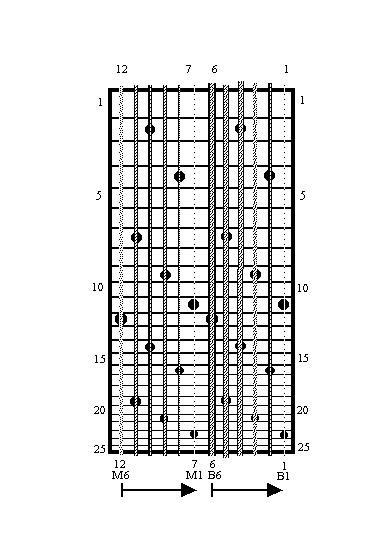In this family, both sides are tuned in fourths and both are ascending in the same direction towards string 1. The hands move both in a parallel guitar-like fashion. The author believes that this is somehow anti-natural, given the symmetric disposition of the hands. However, users of this tuning like its ‘double-guitar feeling’
1.3.1.5.1 Uncrossed parallel fourths

Tuning Word: «1<6_bass_4ths_LH//6_mel_4ths_RH<12» seen from the player.
This tuning is played, for instance, by Jim Wright and Olivier Verschueren (2000) .
The bass string #6 is then in the middle and can bring some trouble playing string #7, the highest of the melody. The construction of the instrument should allow for some space between strings #7 and string #6.If you decide to play this tuning, take care to order an instrument with enough space between Melody 6 strings ( the highest on your RH) and Bass 1 string ( the lowest and thickest of of your LH). The experience shows that B6 can be an obstacle while reaching M1
1.3.1.5.2 Crossed parallel fourths
The tuning word is «1< 6_mel_4ths_RH // 6_bass_4ths_LH // < 12 » seen from the player.
If you take the tuning represented in
Figure 1-8 and flip the bass and melody side, you will have the bass side on the left and the melody on the right. And If you play the bass with the left hand, this means that the hands will be crossed, a serious disadvantage following the author of the present book. This tuning has been adopted by several American players like Teed Rockwell (2000), Traktor Topaz (1997) and the Japanese player Katsu (2001). We give in Table 1-11, the tuning used by Traktor Topaz
| Table 1-11 Crossed hands parallel fourths used by Traktor Topaz on his Megatar ™ | ||||||||||||
| String # | 12 | 11 | 10 | 9 | 8 | 7 | 6 | 5 | 4 | 3 | 2 | 1 |
| Bass/Mel | B6 | B5 | B4 | B3 | B2 | B1 | M6 | M5 | M4 | M3 | M2 | M1 |
| Open at row 0 | B-1 | E0 | A0 | D1 | G1 | C2 | C#1 | F#1 | B1 | E2 | A2 | D3 |
| Gauge “ | .100 | .085 | .065 | .050 | .035 | .025 | .040 | .029 | .016 | .012 | .011 | .009 |